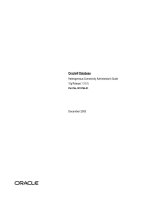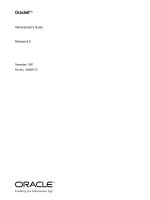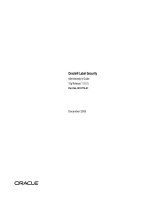MongoDB administrator s guide over 100 practical recipes to efficiently maintain and administer your MongoDB solution
Bạn đang xem bản rút gọn của tài liệu. Xem và tải ngay bản đầy đủ của tài liệu tại đây (2.3 MB, 396 trang )
MongoDB Administrator's Guide
Over 100 practical recipes to efficiently maintain and administer
your MongoDB solution
Cyrus Dasadia
BIRMINGHAM - MUMBAI
MongoDB Administrator's Guide
Copyright © 2017 Packt Publishing
All rights reserved. No part of this book may be reproduced, stored in a
retrieval system, or transmitted in any form or by any means, without the
prior written permission of the publisher, except in the case of brief
quotations embedded in critical articles or reviews.
Every effort has been made in the preparation of this book to ensure the
accuracy of the information presented. However, the information contained in
this book is sold without warranty, either express or implied. Neither the
author, nor Packt Publishing, and its dealers and distributors will be held
liable for any damages caused or alleged to be caused directly or indirectly by
this book.
Packt Publishing has endeavored to provide trademark information about all
of the companies and products mentioned in this book by the appropriate use
of capitals. However, Packt Publishing cannot guarantee the accuracy of this
information.
First published: October 2017
Production reference: 1241017
Published by Packt Publishing Ltd.
Livery Place
35 Livery Street
Birmingham
B3 2PB, UK.
ISBN 978-1-78712-648-0
www.packtpub.com
Credits
Author
Copy Editor
Cyrus Dasadia
Safis Editing
Reviewers
Project Coordinator
Nilap Shah
Nidhi Joshi
Ruben Oliva Ramos
Commissioning Editor
Proofreader
Amey Varangaonkar
Safis Editing
Acquisition Editor
Indexer
Viraj Madhav
Aishwarya Gangawane
Content Development Editor
Graphics
Cheryl Dsa
Tania Dutta
Technical Editor
Production Coordinator
Dinesh Pawar
Shantanu Zagade
About the Author
Cyrus Dasadia has enjoyed tinkering with open source projects since 1996.
He has been working as a Linux system administrator and part-time
programmer for over a decade. He works at InMobi, where he loves
designing tools and platforms. His love for MongoDB blossomed in 2013,
when he was amazed by its ease of use and stability. Since then, almost all of
his projects have been written with MongoDB as the primary backend. Cyrus
is also the creator of an open source alert management system called
CitoEngine. His spare time is devoted to trying to reverse-engineer software,
playing computer games, or increasing his silliness quotient by watching
reruns of Monty Python.
About the Reviewers
Nilap Shah is a lead software consultant with experience across various
fields and technologies. He is expert in .NET, Uipath (Robotics) and
MongoDB. He is certified MongoDB developer and DBA. He is technical
writer as well as technical speaker. He is also providing MongoDB corporate
training. Currently, he is working as lead MongoDB consultant and providing
solutions with MongoDB technology (DBA and developer projects). His
LinkedIn profile can be found at and
can be reachable +91-9537047334 on WhatsApp.
Ruben Oliva Ramos is a computer systems engineer from Tecnologico de
Leon Institute, with a master's degree in computer and electronic systems
engineering, teleinformatics, and networking specialization from the
University of Salle Bajio in Leon, Guanajuato, Mexico. He has more than 5
years of experience in developing web applications to control and monitor
devices connected with Arduino and Raspberry Pi using web frameworks and
cloud services to build the Internet of Things applications.
He is a mechatronics teacher at the University of Salle Bajio and teaches
students of the master's degree in design and engineering of mechatronics
systems. Ruben also works at Centro de Bachillerato Tecnologico Industrial
225 in Leon, Guanajuato, Mexico, teaching subjects such as electronics,
robotics and control, automation, and microcontrollers at Mechatronics
Technician Career; he is a consultant and developer for projects in areas such
as monitoring systems and datalogger data using technologies (such as
Android, iOS, Windows Phone, HTML5, PHP, CSS, Ajax, JavaScript,
Angular, and ASP.NET), databases (such as SQlite, MongoDB, and
MySQL), web servers (such as Node.js and IIS), hardware programming
(such as Arduino, Raspberry pi, Ethernet Shield, GPS, and GSM/GPRS,
ESP8266), and control and monitor systems for data acquisition and
programming.
He has authored the book Internet of Things Programming with
JavaScript and Advanced Analytics with R and Tableau by Packt Publishing.
He is also involved in monitoring, controlling, and the acquisition of data
with Arduino and Visual Basic .NET for Alfaomega.
I would like to thank my savior and lord, Jesus Christ, for giving me the
strength and courage to pursue this project; my dearest wife, Mayte; our two
lovely sons, Ruben and Dario; my dear father, Ruben; my dearest mom,
Rosalia; my brother, Juan Tomas; and my sister, Rosalia, whom I love, for
all their support while reviewing this book, for allowing me to pursue my
dream, and tolerating not being with them after my busy day job.
I'm very grateful to Pack Publishing for giving the opportunity to collaborate
as an author and reviewer, to belong to this honest and professional team.
www.PacktPub.com
For support files and downloads related to your book, please visit www.PacktPub
.com. Did you know that Packt offers eBook versions of every book published,
with PDF and ePub files available? You can upgrade to the eBook version at
www.PacktPub.com and as a print book customer, you are entitled to a discount
on the eBook copy. Get in touch with us at for more
details. At www.PacktPub.com, you can also read a collection of free technical
articles, sign up for a range of free newsletters and receive exclusive
discounts and offers on Packt books and eBooks.
/>
Get the most in-demand software skills with Mapt. Mapt gives you full
access to all Packt books and video courses, as well as industry-leading tools
to help you plan your personal development and advance your career.
Why subscribe?
Fully searchable across every book published by Packt
Copy and paste, print, and bookmark content
On demand and accessible via a web browser
Customer Feedback
Thanks for purchasing this Packt book. At Packt, quality is at the heart of our
editorial process. To help us improve, please leave us an honest review on
this book's Amazon page at />If you'd like to join our team of regular reviewers, you can email us at
We award our regular reviewers with free eBooks
and videos in exchange for their valuable feedback. Help us be relentless in
improving our products!
Table of Contents
Preface
What this book covers
What you need for this book
Who this book is for
Sections
Getting ready
How to do it…
How it works…
There's more…
See also
Conventions
Reader feedback
Customer support
Downloading the example code
Errata
Piracy
Questions
1.
Installation and Configuration
Introduction
Installing and starting MongoDB on Linux
Getting ready
How to do it…
How it works…
There's more…
Installing and starting MongoDB on macOS
Getting ready
How to do it...
How it works…
Binding MongoDB process to a specific network interface and port
Getting ready
How to do it...
How it works...
Enabling SSL for MongodDB
Getting ready
How to do it..
How it works...
There's more…
Choosing the right MongoDB storage engine
WiredTiger
MMAPv1
The verdict
Changing storage engine
Getting ready
How to do it...
How it works...
Separating directories per database
Getting ready
How to do it...
How it works...
Customizing the MongoDB configuration file
Getting ready
How to do it..
How it works...
There's more...
Running MongoDB as a Docker container
Getting ready
How to do it...
How it works...
There's more..
2.
Understanding and Managing Indexes
Introduction
Creating an index
Getting ready
How it works...
There's more...
Managing existing indexes
Getting ready
How to do it...
How it works...
How to use compound indexes
Getting ready
How to do it...
How it works…
There's more...
Creating background indexes
Getting ready
How to do it...
How it works...
Creating TTL-based indexes
Getting ready
How to do it...
How it works...
There's more...
Creating a sparse index
Getting ready
How to do it...
How it works...
Creating a partial index
Getting ready
How to do it...
How it works...
Creating a unique index
Getting ready
How to do it...
How it works...
3.
Performance Tuning
Introduction
Configuring disks for better I/O
Reading and writing from disks
Few considerations while selecting storage devices
Measuring disk I/O performance with mongoperf
Getting ready
How to do it...
How it works...
Finding slow running queries and operations
Getting ready
How to do it...
How it works...
There's more...
Storage considerations when using Amazon EC2
Figuring out the size of a working set
There's more...
4.
High Availability with Replication
Introduction
Initializing a new replica set
Getting ready
How to do it...
How it works...
Adding a node to the replica set
Getting ready
How to do it...
How it works...
Removing a node from the replica set
Getting ready
How to do it...
How it works...
Working with an arbiter
Getting ready
How to do it...
How it works...
Switching between primary and secondary nodes
Getting ready
How to do it...
How it works...
Changing replica set configuration
Getting ready
How to do it...
How it works..
Changing priority to replica set nodes
Getting ready
How to do it...
How it works...
There's more...
5.
High Scalability with Sharding
Understanding sharding and its components
Components of MongoDB sharding infrastructure
Config server
The mongos query router
The shard server
Choosing the shard key
Setting up and configuring a sharded cluster
Getting ready
How to do it...
How it works...
Managing chunks
Getting ready
How to do it...
How it works...
Moving non-sharded collection data from one shard to another
Getting ready
How to do it...
How it works...
Removing a shard from the cluster
Getting ready
How to do it...
How it works...
Understanding tag aware sharding – zones
Getting ready
How to do it...
How it works...
See also
6.
Managing MongoDB Backups
Introduction
Taking backup using mongodump tool
Getting ready
How to do it...
How it works...
There's more...
Taking backup of a specific mongodb database or collection
Getting ready
How to do it...
How it works...
Taking backup of a small subset of documents in a collection
Getting ready
How to do it...
How it works...
Using bsondump tool to view mongodump output in human readable form
Getting ready
How to do it...
How it works...
Creating a point in time backup of replica sets
Getting ready
How to do it...
How it works...
Using the mongoexport tool
Getting ready
How to do it...
How it works...
Creating a backup of a sharded cluster
Getting ready
How to do it...
How it works...
7.
Restoring MongoDB from Backups
Introduction
Restoring standalone MongoDB using the mongorestore tool
Getting ready
How to do it...
How it works...
Restoring specific database or specific collection
Getting ready
How to do it...
How it works...
Restoring data from one collection or database to another
Getting ready
How to do it...
How it works...
Creating a new MongoDB replica set node using backups
Getting ready
How to do it...
How it works...
Restoring a MongoDB sharded cluster from backup
Getting ready
How to do it...
How it works...
8.
Monitoring MongoDB
Introduction
Monitoring MongoDB performance with mongostat
Getting ready
How to do it...
How it works...
See also
Checking replication lag of nodes in a replica set
Getting ready
How to do it...
How it works...
Monitoring and killing long running operations on MongoDB
Getting ready
How to do it...
How it works...
See also
Checking disk I/O usage
Getting ready
How to do it...
How it works...
Collecting MongoDB metrics using Diamond and Graphite
Getting ready
How to do it...
How it works...
See also
9.
Authentication and Security in MongoDB
Introduction
Setting up authentication in MongoDB and creating a superuser account
Getting ready
How to do it...
How it works...
Creating normal users and assigning built-in roles
Getting ready
How to do it...
How it works...
See also...
Creating and assigning custom roles
Getting ready
How to do it...
How it works...
Restoring access if you are locked out
Getting ready
How to do it...
How it works...
Using key files to authenticate servers in a replica set
Getting ready
How to do it...
How it works...
There's more...
10.
Deploying MongoDB in Production
Introduction
Configuring MongoDB for a production deployment
Getting ready
How to do it...
Upgrading production MongoDB to a newer version
Getting ready
How to do it...
There's more...
Setting up and configuring TLS (SSL)
Getting ready
How to do it...
How it works...
There's more...
Restricting network access using firewalls
Getting ready
How to do it...
How it works...
See also
Preface
MongoDB is an extremely versatile NoSQL database that offers performance,
scalability, and reliability of data. It has slowly become one of the leading
NoSQL database systems used for storing extremely large datasets. In
addition to this, the fact that it is open source makes it the perfect candidate
for any project. From prototyping a minimal viable product to storing
millions of complex documents, MongoDB is clearly emerging as the go-to
database system.
This book aims to help the reader in operating and managing MongoDB
systems. The contents of this book are divided into sections covering all the
core aspects of administering MongoDB systems. The primary goal of this
book is not to duplicate the MongoDB documentation, but to gently nudge
the reader towards topics that are often overlooked when designing
MongoDB systems.
What this book covers
Installation and Configuration, covers the basic details of how to
install MongoDB, either from the bundled binaries or through the operating
system's package managers. It also covers configuration details, as well as
how to install MongoDB in a Docker container.
Chapter 1,
Understanding and Managing Indexes, gives a quick overview of the
benefits of indexes, their various types, and how to optimize database
responses by choosing the correct indexes.
Chapter 2,
Performance Tuning, covers various topics that can help optimize
the infrastructure to deliver optimal database performance. We discuss disk
I/O optimization, measuring slow queries, storage considerations in AWS,
and managing working sets.
Chapter 3,
High Availability with Replication, shows how to achieve high
availability using MongoDB replica sets. Topics such as the configuration of
replica sets, managing node subscriptions, arbiters, and so on are covered.
Chapter 4,
High Scalability with Sharding, covers MongoDB's high scalability
aspects using shards. The topics covered in this section include setting up a
sharded cluster, managing chunks, managing non-sharded data, adding and
removing nodes from the cluster, and creating a geographically distributed
sharded cluster.
Chapter 5,
Managing MongoDB Backups, helps the reader understand how to
select an optimum backup strategy for their MongoDB setup. It covers how
to take backups of standalone systems, replica sets, analyzing backup files,
and so on.
Chapter 6,
Restoring MongoDB from Backups, shows various techniques for
restoring systems from previously generated backups. Topics covered include
restoring standalone systems, specific databases, the backup of one database
Chapter 7,
to another database, replica sets, and sharded clusters.
Monitoring MongoDB, illustrates various aspects of monitoring the
health of a MongoDB setup. This chapter includes recipes for using mongostat,
monitoring replica set nodes, monitoring long-running operations, checking
disk I/O, fetching database metrics, and storing them in a time-series database
such as Graphite.
Chapter 8,
Authentication and Security in MongoDB, looks into various aspects
involved in securing a MongoDB infrastructure. Topics covered in this
chapter include creating and managing users, implementing role-based access
models, implementing SSL/TLS-based transport mechanisms, and so on.
Chapter 9,
Deploying MongoDB in Production, provides insights into
deploying MongoDB in a production environment, upgrading servers to
newer versions, using configuration management tools to deploy MongoDB,
and using Docker Swarm to set up MongoDB in containers.
Chapter 10,
What you need for this book
For the most part, this book requires only MongoDB 3.4 or higher. Although
most of the operating system commands used throughout the book are for
Linux, the semantics is generic and can be replayed on any operating system.
It may be useful to have some knowledge of how MongoDB works, but for
the most part, all chapters are verbose enough for beginners as well.









